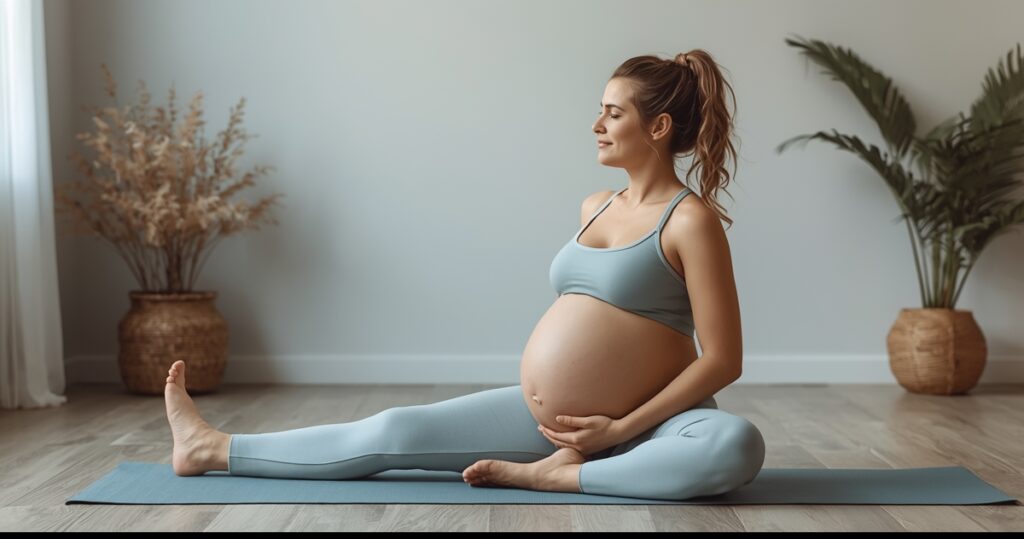During pregnancy, it’s important to stay active, but it’s equally important to rest when needed. Prenatal Yoga provides the perfect balance, allowing you to connect with your body, strengthen muscles, increase flexibility, and improve balance.

These benefits contribute to overall mental and physical relaxation, helping to reduce pregnancy discomfort and create a positive mindset. Yoga will also teach you how to adapt to the myriad of changes your body goes through during pregnancy.
First Trimester: Key Yoga Poses
During the first trimester, you can continue your usual physical activity but should make adjustments as needed. Focus on building strength and reducing tension, especially in the back and lower back.
Some yoga poses such as forward bends are generally safe, but avoid bending too fast or too deep. Listen to your body and change poses if anything feels uncomfortable.
Poses to avoid in the first trimester:
![]() Severe spinal twists, twists, and excessive forward bends
Severe spinal twists, twists, and excessive forward bends
![]() Severe abdominal contractions
Severe abdominal contractions
![]() Inversions (if you’re new to them)
Inversions (if you’re new to them)
![]() High-impact moves like jumping jacks
High-impact moves like jumping jacks
![]() Hot yoga sessions
Hot yoga sessions
Understanding Your Changing Body
Pregnancy places significant demands on your body, so it’s important to adjust your practice based on how you feel each day. A pose that feels comfortable one day may feel uncomfortable the next. Always listen to your body and consult a healthcare provider before starting any exercise routine. Working with a certified prenatal yoga instructor can also be helpful.
Head-to-Knee Forward Bend (Janu Sirsasana)
This forward bend strengthens the back, stimulates digestion, and promotes relaxation while stretching the back, lower back, and legs.

- Sit on the edge of a cushion or block with your left leg extended.
- Place the sole of your left foot on the inside of your right thigh.
- Inhale, raising your arms.
- Exhale, slowly bend forward, lengthening your torso.
- Hold for 1 minute and repeat on the other side.
Modification:
- Use a cushion or block under your knees for support.
- Don’t bend too far forward.
- Use a strap around your feet for support.
Wide-Angle Seated Forward Bend (Upavistha Konasana)
This pose increases flexibility in your back, hips, and legs and strengthens your spine and abdomen.

- Sit with your legs spread out on a cushion or blanket.
- Reach your arms overhead and bend forward at the waist.
- Place your hands in front of you or hold your big toes.
- Hold for 1 minute.
Modification:
- If your legs are stiff, bring them closer together.
- If your legs are stiff, place a cushion under your knees.
Cat-Cow Pose (Marjaryasana to Bitilasana)

- A gentle flow that reduces tension, increases spinal mobility, and increases circulation.
- Start on all fours.
- Inhale, arch your back, pull your belly in, and look up.
- Exhale, round your spine, tuck your chin to your chest.
- Continue for 1 minute.
Yoga Poses for the Second Trimester
In the second trimester, your body begins to produce the hormone relaxin, which loosens ligaments in preparation for labor. This can make you more flexible, so be careful and avoid overstretching.
Read More: The Ultimate Guide to Aerial Yoga
Poses to avoid in the second trimester:
![]() Severe backbends, twisting, and forward bends
Severe backbends, twisting, and forward bends
![]() Strong abdominal contractions
Strong abdominal contractions
![]() Inversions (until you are comfortable with them)
Inversions (until you are comfortable with them)
![]() High-impact movements like inversions (jumping)
High-impact movements like inversions (jumping)
![]() Lying on your back or right side
Lying on your back or right side
Bound Angle Pose

- This pose stretches the inner thighs, hips, and lower back, preparing the body for labor.
- Sit on a cushion or block with your pelvis tilted forward.
- Press the soles of your feet together and bring them close to your body.
- Root your lower body into the floor and lengthen your spine.
- Place your toes under your little toes or ankles.
- Hold for 1 minute and repeat 2-4 times.
Modifications:
- Use cushions or blocks under your knees for support.
- Lie down in a supported position if needed, with your head elevated.
Child’s Pose (Balasana)

- This calming pose stretches the shoulders, chest, and lower back and flexes the spine.
- Start on all fours, bring your big toes together, and spread your knees apart.
- Sit your hips back over your heels and extend your arms forward.
- Hold for up to 1 minute.
Modification:
- Place a cushion under your forehead for support.
- If you need extra space for your belly, spread your legs wider.
Third Trimester Yoga Poses
As your baby grows, you may find it harder to breathe or move comfortably. Focus on gentle movements, resting when needed.
Poses to avoid during the third trimester:
![]() Intense backbends, twists, and forward bends
Intense backbends, twists, and forward bends
![]() Strong abdominal contractions
Strong abdominal contractions
![]() Inversions (unless you’re experienced)
Inversions (unless you’re experienced)
![]() High-impact movements like jumping
High-impact movements like jumping
![]() Lying on your back or right side
Lying on your back or right side
Warrior II (Virabhadrasana II)
This powerful pose strengthens the body, opens the hips, and relieves neck and back tension.

- From standing, step your left foot back and angle your toes outward.
- Align the inside of your left foot with your right heel.
- Open your hips to the side, raising your arms parallel to the floor.
- Bend your right knee, ensuring it doesn’t extend beyond your ankle.
- Hold for 30 seconds, then switch sides.
Modifications:
- Use a wall for support.
- Decrease the bend in your front knee or shorten your stance.
Garland Pose (Malasana)
This deep squat opens the hips and supports digestion, but avoid if prone to prolapse.

- Stand with feet wide and toes turned outward.
- Slowly bend your knees and lower your hips.
- Press your palms together at your chest and gently press elbows into your knees.
- Hold for up to 30 seconds.
Modifications:
- Sit on a cushion for support.
- Position yourself near a wall for balance.
Conclusion
Prenatal yoga is a wonderful practice for expectant mothers, offering numerous benefits that support physical and mental well-being during pregnancy. By practicing safe and appropriate asanas, you can increase strength, flexibility, and relaxation while preparing your body for labor and delivery. Each trimester presents unique challenges, but with the right adjustments and modifications, yoga can be a calming and empowering tool on your pregnancy journey.
Remember, always listen to your Body and consult your healthcare provider before starting any exercise routine. With mindfulness and gentle movements, prenatal yoga can help you stay connected to your body, reduce discomfort, and enhance a positive pregnancy experience.
Take time to relax, modify your asanas as needed, and enjoy the process of nurturing both your body and mind during this time of transformation.
Frequently Asked Questions
Q1. Can I practice prenatal yoga during pregnancy?
Yes, prenatal yoga is safe, with variations in all three positions. Each position is more beneficial and your body should be trained in the correct postures. Always consult your doctor or study the exact prenatal yoga postures.
Q2. What are the benefits of prenatal yoga during pregnancy?
Prenatal yoga helps in increasing flexibility, strength, flexibility, and blood circulation. It can also help in improving posture, calmness, and mental peace and preparing the body for delivery.
Q3. Are there any yoga poses that are good to do during pregnancy?
Yes, certain poses are good during pregnancy, such as deep backbends, abdominal contractions, inversions, and high-impact stretches. It is also advisable to avoid twisting and bending or straining poses after the first trimester.
Q4. Is prenatal yoga safe for someone who has no prior yoga experience?
Yes, prenatal yoga is available for beginners. The key is to maximize gentle stretching and listen to your body. If you are new to it, it is best to join a class specifically for pregnant women and always move into poses as needed.
Q5. How long should I practice prenatal yoga?
Aim for 2-3 20-30 minute prenatal yoga sessions. Aim for a good one. Integrate your body and push yourself harder. Less distractions can be just as beneficial as more practice.
Q6. Can prenatal yoga help with labor and delivery?
Yes, regular prenatal yoga practice can help prepare your body for labor by improving strength, flexibility, and relaxation. Yoga encourages deep breathing techniques that are helpful during labor. It also encourages poses and positions for a comfortable birth.




